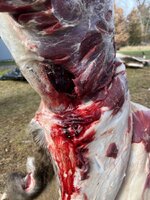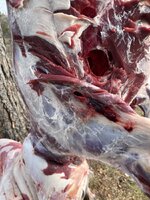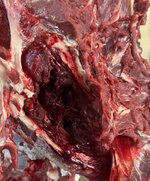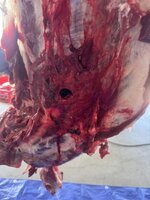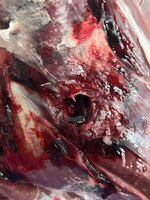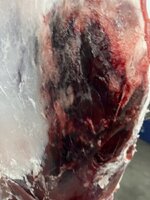Okay, it's taken a fair amount of time, but I have compiled every necropsy report I could locate on both Rokslide (this thread,) as well as the one referenced in this thread located on the LRH Forum. If you know of other good collections please send me links and I will continue to add to this database. In total I have 62 different necropsy reports for the Copper Rose bullets in all different calibers. I've attached a pdf version to this thread. Every entry has a link to the original post.
A few things jump out to me although these are far from conclusions with less than 70 data entries.
1-The bullet appears to create impressively large wound channels at times. There are 10 entries with wound channels estimated to be 3" or larger which I would place on the "really large" end of the spectrum.
2-There were 9 entries with wound channels that appeared to be 1" or smaller though.
3-There was a clear difference in wound channels depending on caliber with 6mm/.243 average wound channel at 1.5" and 7.62mm/.308 at 2.5". The overall average wound channel size was 1.9"
4-Average yards to incapacitation was 30 yards but the sample size was quite small as very few of the submissions included this data point. PLEASE INCLUDE DISTANCE TO INCAPACITATION in your necropsy reports. That and wound channel pics are really critical to good data comparisons.
5-Overall 8 reports had no exit wound, 40 reported exit wounds and 14 didn't report. That is an 83 percent exiting ratio.
6-Finally, 23 of the necropsy reports appeared to show clearly oblong wound channels which I have come to understand may indicate a tumbling bullet. There doesn't appear to be a relationship between caliber or impact velocity with this wound pattern although this has not been looked at closely yet.
For comparisons sake I've attached the data I have compiled for 6mm/.243 caliber bullets in the softer fragmenting category (along with DTAC w/Nosering which is a tumbler.) There are 91 reports in that database which are all from the .243 for big game thread here on Rokslide. At 2.1" average wound size is larger than all but .308 caliber in copper rose. The ratio of large (>3") and small (<1") wound channels appears to be very similar. Average yards to incapacition is slightly smaller, although I don't trust this number because of the tiny number of necropsy reports on the copper rose that actually included this data point. And the number of exit wounds is significantly smaller with the softer 6mm bullets at 56%.
Most interesting to me is the higher exit wound ratio of the Copper Rose and the larger wound channels for that bullet as caliber size grows. None of this is rocket science and seems to me to track with the science and relationship between caliber, impact velocity and bullet type. As an aside, it was really fun to see all of the different calibers in the various reports. 270 Sherman! 338 Lapua! even a good 'ole 30-06! It reminded me that guns are fun and that animals die when hit in the right spot with just about anything.
Caviates and Talking Points
I feel like I need to point out a few obvious things before others grind my face in them.
1- I'm a total amateur, not a trained ballistician, and not in any way associated with any business in the hunting and gun space except as a consumer and hobbyist. I don't have any point to prove in this analysis and I don't believe I am biased other than I do want to find a non-lead bullet that performs well. I've tried to enter data accurately and honestly. I am sure I've made mistakes in the process, so if you find mistakes please message me and explain what you found, and don't jump to the conclusion that I was trying to sway results.
2-The level of accuracy from self reported necropsy reports is spotty at best. In nearly all cases I ruled out reports that didn't have decent photos of wound tracks or which left key metrics out. However, these field reports are as close as we are going to get to any kind of scientific analysis of actual hunting performance for these bullets. My desire is to gain enough entries in the database where trends can be seen through the static of hunter inaccuracy and my own lack of expertise. I expect that once we build a database that has several hundred entries for each bullet, each caliber and each animal we will start to see some clear trends.
3-Most of the necropsy reports for the Copper Rose bullets were submitted by the owner of the company. While this is an obvious and understandable reason to omit bad results and highlight good results I saw nothing in the entries that seemed fudged or exaggerated. And the ones that were just glorified "grip and grins" with not wound photos or data got left out of the database. As a side note, it is really unfortunate that most of us feel so hesitant to post stories and photos about the ugly kills and rodeos we've all been part of. I think because of this bias to success we get to see only the good to great kill reports. I get it though!
4-Many of the reports provide a muzzle velocity and a distance to impact. At some point I will go through and extrapolate the estimated impact velocities using 4DOF.
5-After starting this exercise I understand that while not perfect, ballistic gel testing is a better way to prove a bullet's likely performance than field reports. I repeat here my cry for scientifically robust terminal ballistic testing in FBI gel for hunting bullets at various impact velocities. I believe this is the single most important data set that should and could be provided to us hunters to aid in our selection of hunting bullets. I guess we'd have to throw actual standardized BC data for bullets as well for those hunting past 500 yards.
6-Final thought, I would LOVE for this database to grow and grow. To that end, if you wish to help enter data from forum posts please message me and I can send you the spreadsheet format. I will make sure to give you credit for your work. The only data point that is subjective is the wound channel size as it's a estimate based off of photos and we all have a slightly different internal scale. To that end, I should probably continue to do the size estimation so they are consistent.
DO


